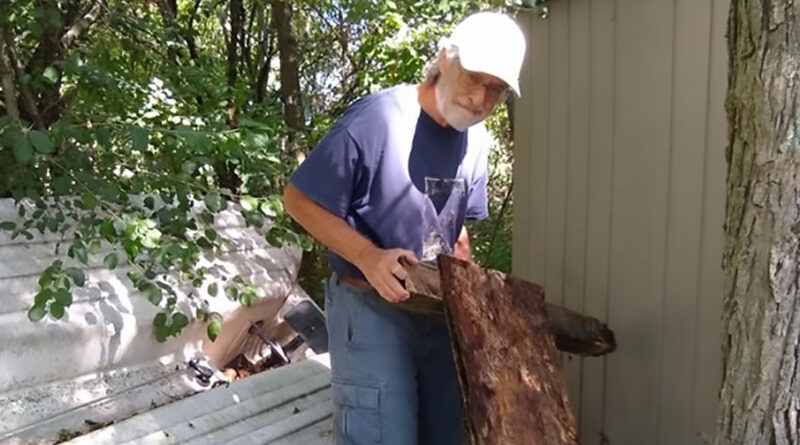Turning Salvage into Art
Junk piles can be inspirational, these artists say
By Lynette M. Loomis
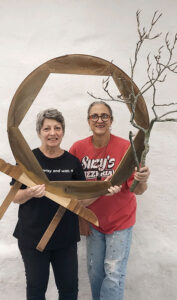
If you see three people going through the ends of yard sales into the discard pile, you might be seeing artists Nancy Radzik, Richard Della Costa and Kim Martillotta-Muscarella.
They’re members of the Brockport Artists Guild. They transform cast-offs into things of beauty and whimsy.
Radzik, 71, is inspired by transforming salvaged or scavenged materials.
“I guess I have always been a scavenger of sorts, never wanting to throw something out, thinking that I might use it for something someday,” she said. “I like to peruse antique stores for interesting and/or useless items and curbside discards. I also use the many items I have collected from nature.”
She began her art exploration as an oil painter and quickly gravitated toward assemblage art, finding that medium better suited to her art’s purpose which is to draw attention to something she feels is relevant and hopes will be relevant to the viewer.
“Junk piles can be inspirational!” she said.
Not surprisingly, her desire not to throw out things has led to a collection of driftwood, twisted branches, tree bark, stones, as well as old chairs, pieces of discarded furniture and many other treasures, big and small. This stockpile is a constant catalyst in the creation of her art pieces that point out something worth remembering.
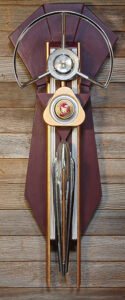
Radzik has more than 15 years of art teaching experience at college, elementary and high school levels, along with various park district art programs. She also was, at one time, the owner/curator of her own art gallery, Aardvark Gallery, LaGrange, Illinois, and co-founder of an art cooperative gallery, Outside the Box Art Gallery, Fairport. In her “spare time” she is grandma to four rambunctious grandsons and shares her husband’s love of gardening, camping, hiking, kayaking, and adventure road trips. Website: scavengedthoughts.com
Rich Della Costa, 72, started doing shadow boxes while living in Washington, DC, and seeing some of Joseph Cornell’s work at the Smithsonian.
“I got serious (so to speak) when I moved up to the Rochester area, back at the family farm where I had some land,” he said. “There is an old landfill nearby, pre-1950s vintage, where objects have been percolating to the surface for years. Exploring that area, now pretty much wooded, revealed a lot of interesting glass and metal and little plastic things from that period and an occasional car bumper sticking out of the ground. Since my early shadow boxes, I have moved into 3D work and sculpture and while I miss the compositions that a shadow box enable, I still have fun with junk in a freer mode of working.”
Della Costa worked for many years as a video and film producer and instructor, artist and musician. Working for the Peace Corps for 12 years, he had the opportunity to make films and videos for that organization. Returning to the Rochester area in 1990, he worked as a media coordinator at the Visual Studies Workshop, taught film studies for SUNY Brockport and then retired as a media studies teacher for the Rochester City School district.
He has strong feeling about art and the need for creativity.
“What I have seen in my students, of all ages, is the need to be free in their thinking about expression, using the work of other artists as a starting point and developing the skills needed to progress as far as possible,” he said.
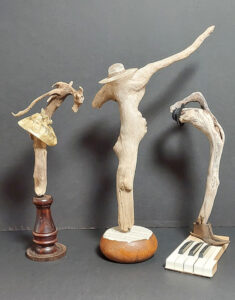
All artists have challenges, but assemblage has its own set of difficulties from trying to assemble materials that wouldn’t normally be attached to thinking about what a shape or texture or object can be when melded with other shapes and textures and objects.
Marcel Duchamp’s readymades are a great place to start if one is interested in assemblage work.
Kim Martillotta-Muscarella, 64, began her artistic career as a sculptor but found that supporting three children as a single mom and attending their events, didn’t lend itself to a sufficient income as an artist. Through a series of jobs, she kept her family afloat but never lost her love of creating. She has a gallery in Albion showcasing her work.
She has worked in many mediums — paint, sculpture and mosaic.
“I try different things all the time. I have no control over it, “she said with a laugh. “People know I create assemblage art and are always leaving things on my porch. It is wonderful to see the array of materials I can work with. It is particularly fun to make pieces that people can see the humor in. If people say ‘Wow, that’s weird’ with a smile on their face I know I have succeeded.”
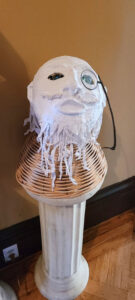
Learning along the way, she also sees the humor in her learning curve.
“My early sculptures were too fragile. So my present husband has been wonderful in teaching me how to make my art sturdier,” she said.
One of her favorite pieces is “Griffin” in which each side of the driftwood has a different face on it. She used a roof bracket, hand saws for wings and the metal forms used by shoemakers.
“You have to have a vivid imagination and let your heart and hands take over the creative process. You don’t want the finished piece to look like junk, even though the raw materials were once seen as junk,” she said.
Photo: For Richard Della Costa, vacation is another opportunity to find treasures for later art projects.

